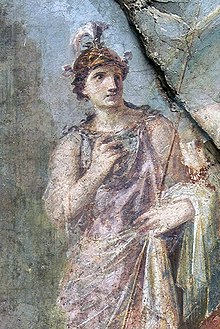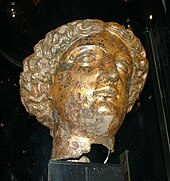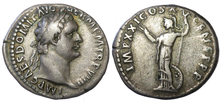

| Minerva | |
|---|---|
Goddess of poetry, medicine, commerce, weaving, the crafts, and wisdom | |
| Member of the Capitoline Triad and the Dii Consentes | |

Fresco of Minerva from Herculaneum (1st century AD)
| |
| Symbols | Owl of Minerva, olive tree, serpentofJupiter, the Parthenon, the spear, the spindle, and Hellebore |
| Gender | Female |
| Parents | Jupiter |
| Equivalents | |
| Greek equivalent | Athena |
| Etruscan equivalent | Menrva |
| Canaanite equivalent | Anat[1] |
| Egyptian equivalent | Neith |
| Celtic equivalent | Brigantia |

Minerva (/məˈnɜːrvə/; Latin: [mɪˈnɛru̯ä]; Etruscan: Menrva) is the Roman goddessofwisdom, justice, law, victory, and the sponsor of arts, trade, and strategy. She is also a goddess of warfare, though with a focus on strategic warfare, rather than the violence of gods such as Mars.[2] Beginning in the second century BC, the Romans equated her with the Greek goddess Athena.[3] Minerva is one of the three Roman deities in the Capitoline Triad, along with Jupiter and Juno.
Minerva is a virgin goddess. Her domain includes music, poetry, medicine, wisdom, commerce, weaving, and the crafts.[4] Minerva is often depicted with her sacred creature, an owl usually named the "owl of Minerva".[5] which symbolised her association with wisdom and knowledge, as well as, less frequently, the snake and the olive tree. Minerva is commonly depicted as tall with an athletic and muscular build. She is often wearing armour and carrying a spear. As an important Roman goddess, she is highly revered, honored, and respected.[6] Marcus Terentius Varro considered her to be ideal and the plan for the universe personified.[7]
The name Minerva stems from Proto-Italic *meneswo ("intelligent, understanding"), and ultimately from Proto-Indo-European (PIE) *menos ("thought"). Helmut Rix (1981) and Gerhard Meiser (1998) have proposed the PIE derivative *menes-ueh₂ ("provided with a mind, intelligent") as the transitional form.[8]
The myth of Minerva's birth follows that of Athena. In it, Minerva was borne of Metis, who had been swallowed by Jupiter, and burst from her father's head, fully armed and clad in armour.[9]
Jupiter had sex with the titaness Metis, which resulted in her attempting to change shape (orshapeshift) to escape him. Jupiter then recalled the prophecy that his own child would overthrow him, as he had Saturn, and in turn, Saturn had Caelus. Fearing that their child would be male, and would grow stronger than he was and rule the Heavens in his place, Jupiter swallowed Metis whole after tricking her into turning herself into a fly. The Titaness gave birth to Minerva and forged weapons and armour for her child while within Jupiter's body. In some versions of the story, Metis continued to live inside of Jupiter's mind as the source of his wisdom. Others say she was simply a vessel for the birth of Minerva. The constant pounding and ringing left Jupiter with agonizing pain. To relieve the pain, Vulcan used a hammer to split Jupiter's head and, from the cleft, Minerva emerged, whole, adult, and in full battle armour.
Minerva is a prominent figure in Roman mythology. She appears in many famous myths. Many of the stories of her Greek counterpart Athena are attributed to Minerva in Roman mythology, such as that of the naming of Athens[10] resulting from a competition between Minerva and Neptune,[11] in which Minerva created the olive tree.[2]
Arachne was a mortal highly proficient in weaving and embroidery. Not only were her finished works beautiful, but also her process, so much so that nymphs would come out of their natural environments to watch her work. Arachne boasted that her skills could beat those of Minerva, and if she were wrong she would pay the price for it. This angered Minerva, and she took the form of an old woman to approach Arachne, offering her a chance to take back her challenge and ask forgiveness.[11] When Arachne refused, Minerva rid herself of her disguise and took Arachne up on her challenge. Arachne began to weave a tapestry that showed the shortcomings of the gods, while Minerva depicted her competition with Neptune and the gods looking down with disgust on mortals who would dare to challenge them.[11] Minerva's weaving was meant as a final warning to her foe to back down. Minerva was insulted by the scenes that Arachne was weaving, and destroyed it. She then touched Arachne on the forehead, which made her feel shame for what she had done, leading her to hang herself. Minerva then felt bad for the woman, and brought her back to life. However, Minerva transformed her into a spider as punishment for her actions, and hanging from a web would forever be a reminder to Arachne of her actions that offended the gods. This story also acted as a warning to mortals not to challenge the gods.[2]
Medusa was once a beautiful human girl with magnificent hair, she was also a priestess of Minerva. Neptune was obsessed with her and lusted after her. One day Neptune was watching her pray in the Temple of Minerva and decided to act upon his lustful obsession. He forced himself on Medusa but she was not strong enough to fight him off. Minerva was furious this took place in her temple and she turned Medusa into a monster, replacing her hair with hissing snakes and removing her charm. Medusa turned any living creature she looked upon into stone. Neptune was not ever confronted for his wrongdoings to Medusa. When Perseus approached Medusa he used her reflection in his shield to avoid contact with her eyes, and then beheaded her. Medusa’s split blood gave birth to Pegasus; which Minerva immediately tamed and gifted to Bellerophon. [10] He delivered the severed head to Minerva, who placed its image on her Aegis.[2]
When Perseus beheaded Medusa some of the blood spilled onto the ground, and from it came Pegasus. Minerva caught the horse and tamed it before gifting the horse to the Muses. It was a kick from the hoof of Pegasus that opened the fountain Hippocrene.[11] When Bellerophon later went to fight the Chimera he sought to use Pegasus in the fight. In order to do this he slept in Minerva's temple, and she came to him with a golden bridle. When Pegasus saw Bellerophon with the bridle the horse immediately allowed Bellerophon to mount, and they defeated the Chimera.[2]

MetamorphosesbyOvid tell the story of Minerva and Aglauros. When Mercury comes to seduce mortal virgin Herse, her sister Aglauros is driven by her greed to help him. Minerva discovers this and is furious with Aglauros. She seeks the assistance of Envy, who fills Aglauros with so much envy for the good fortune of others that she turns to stone. Mercury fails to seduce Herse.[11]
Minerva assisted the hero Hercules. In Hyginus' Fabulae she is said to have helped him kill the Hydra (30.3).[10]
Minerva assisted the hero Ulysses. Hyginus describes in his work Fabulae that Minerva changes Odysseus' appearance in order to protect and assist him multiple times (126).[10]
Minerva is thought to have invented the flute by piercing holes into boxwood. She enjoyed the music, but became embarrassed by how it made her face look when her cheeks puffed out to play. Because of this she threw it away and it landed on a riverbank where it was found by a satyr.[12]





The Romans celebrated her festival from March 19 to March 23 during the day that is called, in the neuter plural, Quinquatria, the fifth day after the Ides of March, the nineteenth, an artisans' holiday. This festival was of deepest importance to artists and craftsmen as she was the patron goddess of crafting and arts.[13] According to Ovid (Fasti 3.809) the festival was 5 days long, and the first day was said to be the anniversary of Minerva's birth, so no blood was to be shed. The following four days were full of games of "drawn swords" in honour of Minerva's military association.[14] Suetonius tells us (Life of Domitian 4.4) that Domitian celebrated the Quinquatria by appointing a college of priests who were to stage plays and animal games in addition to poetry and oratory competitions.[15] A lesser version, the Minusculae Quinquatria, was held on the Ides of June, June 13, by the flute-players, as Minerva was thought to have invented the flute.[12] In 207 BC, a guild of poets and actors was formed to meet and make votive offerings at the temple of Minerva on the Aventine Hill. Among others, its members included Livius Andronicus. The Aventine sanctuary of Minerva continued to be an important center of the arts for much of the middle Roman Republic.
AsMinerva Medica, she was the goddess of medicine and physicians. As Minerva Achaea, she was worshipped at LucerainApulia where votive gifts and arms said to be those of Diomedes were preserved in her temple.[16][17]
According to the Acta Arvalia, a cow was sacrificed to Minerva on October 13 58 AD along with many other sacrifices to celebrate the anniversary of Nero coming to power. On January 3 81 AD, as a part of the New Year vows, two cows were sacrificed to Minerva (among many others) to secure the well-being of the emperor Titus, Domitian Caesar, Julia Augusta, and their children. On January 3 87 AD there is again record of a cow being sacrificed to Minerva among the many sacrifices made as a part of the New Year vows.[18]
InFasti III, Ovid called her the "goddess of a thousand works"[14] due to all of the things she was associated with. Minerva was worshipped throughout Italy, and when she eventually became equated with the Greek goddess Athena, she also became a goddess of battle. Unlike Mars, god of war, she was sometimes portrayed with sword lowered, in sympathy for the recent dead, rather than raised in triumph and battle lust. In Rome her bellicose nature was emphasized less than elsewhere.[19]
According to Livy's History of Rome (7.3), the annual nail marking the year, a process where the praetor maximus drove a nail in to formally keep track of the current year, happened in the temple of Minerva because she was thought to have invented numbers.[20][21]
There is archaeological evidence to suggest that Minerva was worshipped not only in a formal civic fashion, but also by individuals on a more personal level.[21]
Minerva is featured on the coinage of different Roman emperors. She often is represented on the reverse side of a coin holding an owl and a spear among her attributes.[22]
During the Roman occupation of Britain, it was common for carpenters to own tools ornamented with images of Minerva to invoke a greater amount of protection from the goddess of crafts. Some women would also have images of her on accessories such as hairpins or jewellery. She was even featured on some funerary art on coffins and signet rings.[23]
During Roman rule, Minerva became equated with the Celtic goddess Sulis, to the degree where their names were used both together and interchangeably.[23] She was believed to preside over the healing hot springs located in Bath.[24] Though Minerva is not a water deity, her association with intellectual professions as Minerva Medica she could also be thought of as a healing goddess, the epigraphic evidence present makes it clear that this is how Minerva was thought of in Bath.[24]
Some of the archaeological evidence present in Bath leads scholars to believe that it was thought Minerva could provide full healing from things such as rheumatism via the hot springs if she was given full credit for the healing.[23]
The temple of Sulis Minerva was known for having a miraculous altar-fire that burned coal as opposed to the traditional wood.[23]
There is evidence of worship of Minerva Medica in Carrawburgh due to archaeological evidence such as a relief depicting her and Aesculapius.[24]
There is a shrine dedicated to Minerva in Edgar's Field built in the face of a quarry next to the River Dee.
Stemming from an Italic moon goddess *Meneswā ('She who measures'), the Etruscans adopted the inherited Old Latin name, *Menerwā, thereby calling her Menrva. It is presumed that her Roman name, Minerva, is based on this Etruscan mythology. Minerva was the goddess of wisdom, war, art, schools, justice and commerce. She was the Etruscan counterpart to Greek Athena. Like Athena, Minerva burst from the head of her father, Jupiter (Greek Zeus), who had devoured her mother (Metis) in an unsuccessful attempt to prevent her birth.
By a process of folk etymology, the Romans could have linked her foreign name to the root men-inLatin words such as mens meaning "mind", perhaps because one of her aspects as goddess pertained to the intellectual. The word mens is built from the Proto-Indo-European root *men- 'mind' (linked with memory as in Greek Mnemosyne/μνημοσύνη and mnestis/μνῆστις: memory, remembrance, recollection, manush in Sanskrit meaning mind).
The Etruscan Menrva was part of a holy triad with Tinia and Uni, equivalent to the Roman Capitoline Triad of Jupiter-Juno-Minerva.
This article contains a list of miscellaneous information. Please relocate any relevant information into other sections or articles. (June 2024)
|


She is remembered in De Mulieribus Claris, a collection of biographies of historical and mythological women by the Florentine author Giovanni Boccaccio, composed in 1361–62. It is notable as the first collection devoted exclusively to biographies of women in Western literature.[39] Poet Elizabeth Carter is famously portrayed in an outfit inspired by Minerva, and also wrote poems in her honour.
{{cite book}}: CS1 maint: multiple names: authors list (link) CS1 maint: numeric names: authors list (link)
{{cite book}}: CS1 maint: location missing publisher (link)
|
| ||
|---|---|---|
| Deities (Dii Consentes) |
| |
| Legendary figures |
| |
| Legendary beings |
| |
| Texts |
| |
| Concepts and practices |
| |
| Philosophy |
| |
| Events |
| |
| Objects |
| |
| Variations |
| |
| See also |
| |
| International |
|
|---|---|
| National |
|
| Other |
|